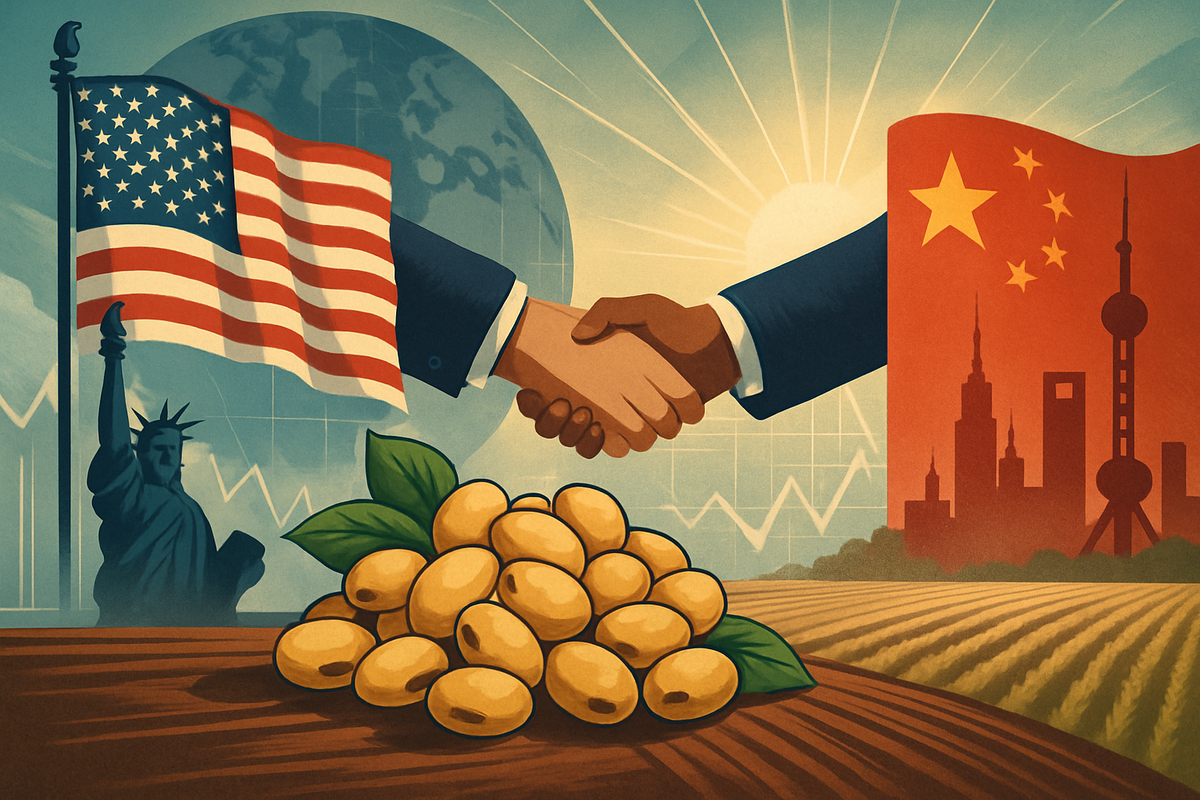
Chicago, IL – October 20, 2025 – Global soybean prices have surged to a month-high, with November futures on the Chicago Board of Trade (CBOT) jumping significantly, propelled by intense market speculation surrounding a potential high-stakes meeting between US President Donald Trump and China’s President Xi Jinping. This renewed optimism for a de-escalation in the protracted trade war between the world's two largest economies has sent ripples through agricultural commodity markets, offering a glimmer of hope to beleaguered American farmers but also highlighting the enduring fragility of global food supply chains.
The rally, which saw soybean prices climb to approximately $1027.19 USd/Bu by October 20, reaching a four-week high of $1030.00 USd/Bu, underscores the profound impact of geopolitical events on agricultural commodity valuations. While the prospect of a diplomatic breakthrough is buoying sentiment, the market remains acutely aware of the historical volatility induced by previous trade rhetoric, leaving stakeholders to cautiously navigate a landscape where political pronouncements can whipsaw prices in an instant.
Geopolitical Tides and the Soybean Market's Volatile Dance
The recent surge in soybean prices is a direct response to President Trump's public expressions of desire for China to resume large purchases of US soybeans, linking this directly to a planned meeting with President Xi Jinping at the Asia-Pacific Economic Cooperation (APEC) summit in South Korea, slated for the end of October. This potential encounter comes after a period of intense trade friction that has fundamentally reshaped the global soybean trade.
The timeline of US-China trade tensions, particularly their impact on soybeans, paints a picture of prolonged disruption. The trade war officially ignited in early 2018, with the US imposing tariffs on steel and aluminum, swiftly followed by China's retaliatory 25% tariff on 128 US products, including soybeans, in April 2018. This move, which saw CBOT soybean futures plummet almost 5% in a single day, marked the beginning of a dramatic shift. By July 2018, reciprocal 25% tariffs were fully in effect, causing soybeans to lose $0.59 per bushel in a week. US soybean exports to China, which constituted 57% of total US soy exports in 2017 ($12.2 billion), collapsed to $3.1 billion (18%) in 2018, a 75% year-over-year drop. China largely turned to Brazil and Argentina to meet its demand.
Despite a "Phase One" trade deal signed in January 2020, which saw a temporary rebound in CBOT soybean futures, China largely failed to meet its purchase targets, exacerbated by the COVID-19 pandemic. By 2024, only 21% of China's soybean imports came from the US, with 71% sourced from Brazil. The situation deteriorated further in 2025; President Trump initiated a new round of tariffs in February, prompting China to respond with its own, including a 10% tariff on soybeans. Beijing subsequently halted soybean purchases from the US in May 2025, redirecting imports to South America, a boycott that continues to this day, with no US soybean imports by China in September 2025. The combined retaliatory tariffs, VAT, and MFN taxes have pushed China's overall duty rate on US soybeans to 34%, effectively pricing American supplies out of the Chinese market.
Key players beyond the presidents have been deeply involved. The U.S. Trade Representative (USTR) has spearheaded tariff investigations, while the U.S. Department of Agriculture (USDA) has provided critical data and support to farmers, with Agriculture Secretary Brooke Rollins advocating for market diversification. The American Soybean Association (ASA) has vocally represented farmers' interests, lobbying for beneficial trade deals. On the trading front, the CME Group / Chicago Board of Trade (CBOT) serves as the barometer for market sentiment, reflecting reactions to every trade-related rumor. China's Ministry of Commerce and Customs Tariff Commission have dictated retaliatory measures, while state-owned enterprises like COFCO and Sinograin have executed import shifts. The agricultural sectors of Brazil and Argentina have emerged as significant beneficiaries, filling the void left by US soybeans in China.
Initial market reactions to trade news have consistently been swift and dramatic. Tariff announcements in 2018 led to immediate price drops, while hopes of a truce, such as the Phase One agreement, spurred rallies. The current speculation about a Trump-Xi meeting is no different, generating a surge of "trade optimism" and "renewed hope" across agricultural markets, despite the underlying structural challenges.
Corporate Fortunes Tied to Trade Winds
The volatile currents of US-China trade relations have profound implications for major players in the agricultural sector, creating clear winners and losers depending on the trajectory of trade talks.
Should the anticipated Trump-Xi meeting lead to a de-escalation of the trade war, major agricultural processors and traders like Archer Daniels Midland (NYSE: ADM) and Bunge Global SA (NYSE: BG) stand to gain significantly. A reduction or removal of tariffs would likely trigger a surge in US soybean crushing and export volumes to China, boosting their agricultural services and oilseeds processing segments. This would allow them to regain lost market share and optimize their supply chains, potentially leading to improved profitability and positive stock performance. While private, Cargill, a global agribusiness giant, would also benefit from increased global trade volumes, though it might face intensified competition for soybeans in Brazil, where it has substantial operations.
Corteva Agriscience (NYSE: CTVA), a leading agricultural science company, would experience an indirect but substantial benefit. Healthier farm incomes in the US, fueled by renewed soybean demand and potentially higher prices, would encourage farmers to invest more in premium seeds and crop protection products, directly boosting Corteva's sales and profitability. Similarly, Deere & Company (NYSE: DE), a manufacturer of agricultural machinery, would see a significant uptick in demand. Farmers, with improved economic prospects, would be more inclined to purchase new equipment, leading to increased sales and production volumes for Deere, and a likely positive reaction in its stock price.
Conversely, a re-escalation or continued stalemate in the trade war would exacerbate existing challenges for these companies. ADM and Bunge would continue to face headwinds in their US operations, with reduced export volumes depressing crushing margins and asset utilization. They would be forced to further rely on South American origins to meet Chinese demand, potentially straining logistics and increasing procurement costs. This scenario would negatively impact their profitability and stock performance.
Corteva would likely see continued financial strain on US farmers, leading to reduced spending on seeds and crop protection, directly hurting its sales and margins. Deere & Company would also face ongoing suppression of demand for agricultural machinery in the US, leading to production cuts and lower sales volumes, with its stock price likely experiencing significant declines. The current environment, with China largely shunning US soybeans and zero new-crop orders for the 2025/26 marketing year, already reflects a challenging scenario for these companies, forcing them to adapt to a "new normal" characterized by diversified global supply chains and heightened geopolitical risks.
Broader Ripples: Food Security, Supply Chains, and Historical Echoes
The speculation surrounding a Trump-Xi meeting and its immediate impact on soybean prices is more than just a market blip; it's a stark reminder of the wider significance of geopolitical events on global agricultural commodity markets, touching upon fundamental issues of food security, supply chain resilience, and international trade dynamics.
This event fits squarely into broader industry trends emphasizing global food security and the extreme sensitivity of commodity markets to political rhetoric. China, in response to the trade war, has strategically prioritized boosting domestic soybean and pork production and diversifying its import partners, notably with Brazil, Argentina, and Russia. This pivot, aimed at reducing reliance on volatile import markets and mitigating supply shocks, has fundamentally reshaped global supply chains. For import-reliant nations, particularly in Asia and Africa, these shifts translate into increased costs and amplified concerns about food insecurity. The trade war has created "fragmented supply chains" and elevated input costs for farmers, ultimately affecting consumer prices globally.
The ripple effects extend across competitors, partners, and related industries. While US farmers have faced declining exports and financial distress, competitors like Brazil and Argentina have significantly benefited, becoming China's primary soybean suppliers. This shift, however, has raised environmental concerns, such as increased deforestation in the Amazon, as land is converted for agricultural expansion. In related industries, the livestock feed industry has been directly impacted, as soybeans are a critical component. Reduced US soybean exports to China led to an oversupply in the US, potentially lowering domestic soybean prices, while China's long-term strategy to reduce reliance on imported feed grains continues to reshape global demand. The food processing industry also faces challenges, with tariffs increasing the cost of imported ingredients and machinery, and retaliatory tariffs making American food products less competitive globally.
Regulatory and policy implications are significant. Both the US and China have utilized tariffs as a primary tool, leading to substantial government support measures for affected US farmers. The trade war has underscored the need for resilient agricultural supply chains, prompting legislative efforts like the "Securing American Agriculture Act" to reduce US dependence on Chinese agricultural inputs. Ongoing high-level diplomatic engagements are crucial for de-escalation, but a lack of progress can lead to missed export opportunities and negative market impacts.
Historically, geopolitical events have consistently disrupted agricultural markets. The Russia-Ukraine conflict (2022), for instance, severely disrupted wheat supply chains, leading to price spikes and increased food trade protectionism. The 1980s grain embargo against the Soviet Union serves as a cautionary tale of protectionist measures backfiring on domestic producers. Even events like the Gulf War (1990-1991) and the Arab Spring demonstrated how geopolitical tensions, through their impact on oil prices or regional stability, can indirectly but profoundly influence agricultural commodity prices and global food security. These historical precedents highlight the interconnectedness and inherent fragility of the global food system in the face of political volatility.
Navigating the Crossroads: What Comes Next
The current speculation surrounding a Trump-Xi meeting places the soybean market at a critical juncture, with both short-term relief and long-term structural shifts on the horizon. The immediate future hinges on the outcome of this potential encounter, but the underlying dynamics of global agricultural trade suggest a more complex path forward.
In the short-term, a confirmed and successful meeting, leading to a significant reduction or removal of the 34% duty on US soybeans, could trigger an immediate and strong rebound in US soybean prices and renewed export demand. This would provide much-needed relief to American farmers facing large supplies and harvest pressure without Chinese orders. However, if the meeting is canceled or yields no substantial progress, prices could plunge, exacerbating the existing challenges. China's current absence from the US new-crop export market for 2025/26 underscores the precariousness of the situation.
The long-term outlook suggests that even with a trade deal, a full return to pre-trade war levels of US soybean exports to China is unlikely. China has strategically diversified its suppliers, cementing relationships with Brazil and Argentina, a structural shift driven by food security concerns rather than temporary tactics. The USDA projects significant declines in US agricultural exports to China through 2026, indicating a more permanent realignment of trade flows. While global demand for soybeans continues to grow (driven by animal protein, aquaculture, and biofuels), US farmers will need to aggressively pursue new markets beyond their historical reliance on China.
Strategic pivots and adaptations are imperative for market players. Farmers and exporters must diversify into new markets in Asia and Africa, leveraging the quality of American soybeans. Increased domestic processing and utilization of soybeans are also crucial. Given the continued volatility, robust risk management and hedging strategies are essential for farmers and traders. Supply chain adjustments, including strengthening relationships with South American suppliers, will continue as global processors prioritize resilience. Farmers may also need to adapt planting decisions, potentially diversifying crops if consistent Chinese demand does not materialize.
Emerging market opportunities include growing demand in other Asian and African economies, the expanding biofuel sector, and the rising demand for soy-based products in the plant-based food industry. However, significant challenges remain, such as entrenched competition from South America, persistent high tariffs, the impact of the US government shutdown on critical market data, rising production costs, and the unpredictable nature of political volatility.
Potential scenarios and outcomes for the soybean market range from a best-case scenario of a significant trade deal leading to a strong price rebound, to a most likely scenario of partial agreement and continued tension, resulting in temporary rallies followed by consolidation, and a worst-case scenario of escalation, leading to significant downward pressure on prices and substantial financial distress for US farmers.
The Road Ahead: Key Takeaways and Investor Watchpoints
The recent surge in soybean prices, fueled by speculation surrounding a potential Trump-Xi meeting, encapsulates the delicate balance between geopolitical rhetoric and market fundamentals in the global agricultural landscape. While the short-term market reaction offers a glimpse of optimism, the long-term trajectory of the soybean market is being reshaped by structural shifts in trade patterns and supply chain diversification.
Key takeaways from this event are clear: political rhetoric remains a potent short-term market driver, but China's strategic diversification of soybean sources represents a fundamental, rather than temporary, shift. Consequently, US farmers continue to face a challenging environment marked by reduced access to their largest historical market and elevated input costs.
Moving forward, the market will remain highly sensitive to diplomatic developments. Investors should closely watch for the concrete outcomes of the Trump-Xi meeting, paying particular attention to any specific announcements regarding tariff reductions or agricultural purchase commitments. Chinese soybean import data, detailing actual purchase volumes from various origins, will be crucial to gauge the effectiveness of China's diversification and any shifts in demand for US soybeans.
Furthermore, monitoring South American crop conditions and export pace will be vital, as these significantly influence global supply and pricing. The eventual release of updated USDA reports, once the current US government shutdown concludes, will provide much-needed clarity on crop progress, yield estimates, and export sales. Domestically, strong US soybean crush rates could offer some price support by absorbing excess supply. Finally, broader trade policy developments between the US and China, beyond just soybeans, could have spillover effects on agricultural negotiations. The growth of global demand for biofuels and plant-based proteins also presents alternative demand drivers for soybeans, lessening reliance on traditional export markets.
The soybean market stands at a crossroads, where political negotiations hold significant short-term sway, but underlying long-term shifts in global trade patterns and supplier diversification are fundamentally reshaping its future. Investors and stakeholders must remain agile, informed, and prepared for continued volatility as this critical commodity navigates the complexities of global geopolitics and evolving market dynamics.
This content is intended for informational purposes only and is not financial advice





